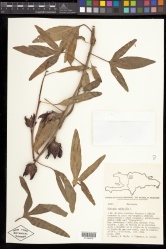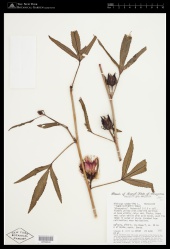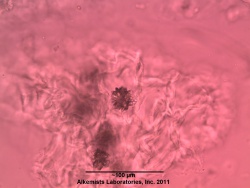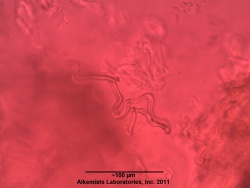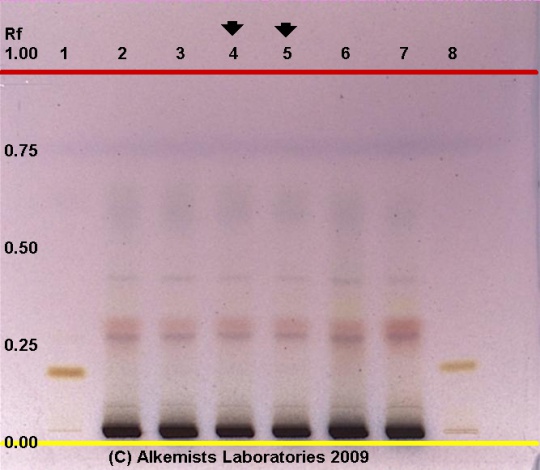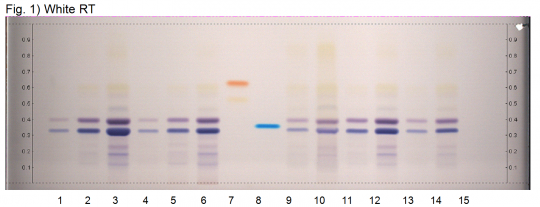Hibiscus sabdariffa (flower)
(add starr voucher specimens) |
|||
| (7 intermediate revisions by 4 users not shown) | |||
| Line 1: | Line 1: | ||
| − | = | + | {{DISPLAYTITLE:''Hibiscus sabdariffa'' (flower) }} {{askbox|herb=''Hibiscus sabdariffa''}} |
| − | =Macroscopic | + | =Nomenclature= |
| − | =Microscopic | + | |
| − | {{Microscopy | source=Elan M. Sudberg, Alkemist Laboratories | + | {{nomenclature | binomial=Hibiscus sabdariffa |
| + | |authority=L. | ||
| + | |family=Malvaceae | ||
| + | |scn=hibiscus | ||
| + | |syn= | ||
| + | |ayurvedic=ambashthaki | ||
| + | |pinyin= | ||
| + | |aka=roselle | ||
| + | |notes= }} | ||
| + | |||
| + | =Botanical Voucher Specimen= | ||
| + | {{Media3 |cat=Voucher | ||
| + | |companyimage=Starr herbarium logo.png | ||
| + | | companyURL=http://sciweb.nybg.org/science2/VirtualHerbarium.asp | ||
| + | |mainimage=Hibiscus sabdariffa L. - Starr - 01439579.jpg | ||
| + | |caption1=''Hibiscus sabdariffa'' L. | ||
| + | |source=Images courtesy of the C.V. Starr Virtual Herbarium of the New York Botanical Garden | ||
| + | |companyimage2=Starr herbarium logo.png | ||
| + | | companyURL2=http://sciweb.nybg.org/science2/VirtualHerbarium.asp | ||
| + | |image2=Hibiscus sabdariffa L. - Starr - 01439580.jpg | ||
| + | |caption2=''Hibiscus sabdariffa'' L. | ||
| + | |source2=Images courtesy of the C.V. Starr Virtual Herbarium of the New York Botanical Garden | ||
| + | |companyimage3=Starr herbarium logo.png | ||
| + | | companyURL3=http://sciweb.nybg.org/science2/VirtualHerbarium.asp | ||
| + | |image3=Hibiscus sabdariffa L. - Starr - 02099646.jpg | ||
| + | |caption3=''Hibiscus sabdariffa'' L. | ||
| + | |source3=Images courtesy of the C.V. Starr Virtual Herbarium of the New York Botanical Garden | ||
| + | |}} | ||
| + | =Organoleptic Characteristics= | ||
| + | |||
| + | =Macroscopic Characteristics= | ||
| + | =Microscopic Characteristics= | ||
| + | {{Media2 |cat=Microscopy | source=Elan M. Sudberg, Alkemist Laboratories | ||
| companyimage= AP-LOGO-Laboratories Crop - Copy.jpg | | companyimage= AP-LOGO-Laboratories Crop - Copy.jpg | ||
| − | | companyURL=http://www. | + | | companyURL=http://www.alkemist.com |
| mainimage=Hibiscus Alkemist Laboratories.jpg | | mainimage=Hibiscus Alkemist Laboratories.jpg | ||
| caption1=Rosettes of Calcium oxalate with pink pigment observed at 400x with Acidified Chloral Hydrate Glycerol Solution. | | caption1=Rosettes of Calcium oxalate with pink pigment observed at 400x with Acidified Chloral Hydrate Glycerol Solution. | ||
| − | + | | source2=Elan M. Sudberg, Alkemist Laboratories | |
| + | | companyimage2= AP-LOGO-Laboratories Crop - Copy.jpg | ||
| + | | companyURL2=http://www.alkemist.com | ||
| image2=Hibiscus-1 Alkemist Laboratories.jpg | | image2=Hibiscus-1 Alkemist Laboratories.jpg | ||
| caption2=Fragment of a thin walled trichome observed at 400x with Acidified Chloral Hydrate Glycerol Solution. | | caption2=Fragment of a thin walled trichome observed at 400x with Acidified Chloral Hydrate Glycerol Solution. | ||
| Line 16: | Line 50: | ||
| − | =HPTLC | + | =High Performance Thin Layer Chromatographic Identification= |
| − | = | + | {{HPTLC | source=Elan M. Sudberg, Alkemist Laboratories |
| − | + | | description=Hibiscus (flower) (''Hibiscus sabdariffa'') | |
| + | | companyimage=AP-LOGO-Laboratories Crop - Copy.jpg | ||
| + | | companyURL=http://www.alkemist.com | ||
| + | | mainimage=Hibiscus_sabdariffa_-_Alkemists_Laboratories.jpg | ||
| + | | caption1=''Hibiscus sabdariffa'' HPTLC ID - Thymol Sulfuric Acid Reagent UV 365 nm | ||
| + | | stationaryphase=Silica gel 60, F254, 10 x 10 cm HPTLC plates | ||
| + | | mobilephase=tolulene: ethyl formate: formic acid [5/4/1] | ||
| + | | prep=0.5 g + 5mL 70%gr EtOH sonicate/heat @ 50° C~1/2 hr, evap w N2, qs 1mL CH3OH | ||
| + | | detection=Thymol Sulfuric acid spray -> 115° C 10 min -> UV 365 nm | ||
| + | | lanes= Lanes, from left to right (Track, Volume, Sample): | ||
| + | # μL Epicatechin ~0.1% in CH3OH | ||
| + | # μL ''Hibiscus sabdariffa''-1 (flower) | ||
| + | # μL ''Hibiscus sabdariffa''-2 (flower) | ||
| + | # μL ''Hibiscus sabdariffa''-3 (flower) | ||
| + | # μL ''Hibiscus sabdariffa''-3 (flower) | ||
| + | # μL ''Hibiscus sabdariffa''-4 (flower) | ||
| + | # μL ''Hibiscus sabdariffa''-5 (flower) | ||
| + | # μL Catechin ~0.1% in CH3OH | ||
| + | |||
| + | Reference materials used here have been authenticated by macroscopic, microscopic &/or TLC studies according to the reference source cited below held at Alkemists Pharmaceuticals, Costa Mesa, CA. | ||
| + | |||
| + | | reference=Thin-Layer Chromatography Jork, Funk Wimmer P421-424 | ||
| + | | }} | ||
| + | |||
| + | {{HPTLC | source=HPTLC Association | ||
| + | | companyimage=HPTLC-assoc-Logo-farbig-Text-schwarz-300x47.png | ||
| + | | companyURL=http://www.hptlc-association.org/ | ||
| + | | mainimage=Hibiscus sabdariffa flower-hptclc-association.png | ||
| + | | caption1=Roselle (flower) HPTLC ID - White RT | ||
| + | | description=Roselle (flower) (''Hibiscus sabdariffa'') | ||
| + | | | ||
| + | | stationaryphase=Stationary phase, i.e. Silica gel 60, F254 | ||
| + | | mobilephase=1-Butanol, formic acid, water 40:10:12: (v/v/v) | ||
| + | | prep=Sample: Mix 1 g of powdered sample with 10 mL of methanol and sonicate for 10 minutes, then centrifuge or filter the solutions and use the supernatants /filtrates as test solutions. | ||
| + | |||
| + | | detection=Saturated chamber; developing distance 70 mm from lower edge; relative humidity 33% | ||
| + | | referencesamples=Reference: Dissolve 2.6 mg of patent blue V in 10 mL of ethanol. Dissolve 2.8 mg of quinaldine red in 10 mL of ethanol. | ||
| + | | | ||
| + | | lanes=Lanes, from left to right (Track, Volume, Sample): | ||
| + | # 1.0 µL Roselle flower 1 | ||
| + | # 3.0 µL Roselle flower 1 | ||
| + | # '''6.0 µL Roselle flower 1''' | ||
| + | # 0.5 µL Roselle flower 1 (Ph. Eur. extract.) | ||
| + | # 1.0 µL Roselle flower 1 (Ph. Eur. extract.) | ||
| + | # 2.0 µL Roselle flower 1 (Ph. Eur. extract.) | ||
| + | # 2.0 µL Quinaldine red | ||
| + | # 2.0 µL Patent blue V | ||
| + | # 8.0 µL Roselle flower 2 | ||
| + | # 16.0 µL Roselle flower 2 | ||
| + | # 3.0 µL Roselle flower 3 | ||
| + | # '''6.0 µL Roselle flower 3''' | ||
| + | # 3.0 µL Roselle flower 4 | ||
| + | # '''6.0 µL Roselle flower 4''' | ||
| + | |||
| + | | notes=''Images presented in this entry are examples and are not intended to be used as basis for setting specifications for quality control purposes.'' | ||
| + | |||
| + | System suitability test: Patent blue V: blue zone at Rf ~ 0.36; Quinaldine red: orange zone at Rf ~ 0.63. | ||
| + | |||
| + | Identification: Compare result with reference images. The fingerprint of the test solution is similar to that of the corresponding botanical reference sample. Additional weak zones may be present. The test solution shows two violet-blue zones at Rf ~ 0.33 and Rf ~ 0.40. | ||
| + | | }} | ||
| + | |||
| + | =Supplementary Information= | ||
| + | =Sources= | ||
| + | <references /> | ||
Latest revision as of 18:14, 21 July 2015
Contents |
Nomenclature
Hibiscus sabdariffa L. Malvaceae
Standardized common name (English): hibiscus
Ayurvedic name(s): ambashthaki
Botanical Voucher Specimen
|
|
|
|
Organoleptic Characteristics
Macroscopic Characteristics
Microscopic Characteristics
 |
 |
|
|
|
High Performance Thin Layer Chromatographic Identification
|
Hibiscus (flower) (Hibiscus sabdariffa) Lane Assignments Lanes, from left to right (Track, Volume, Sample):
Reference materials used here have been authenticated by macroscopic, microscopic &/or TLC studies according to the reference source cited below held at Alkemists Pharmaceuticals, Costa Mesa, CA. Stationary Phase Silica gel 60, F254, 10 x 10 cm HPTLC plates Mobile Phase tolulene: ethyl formate: formic acid [5/4/1] Sample Preparation Method 0.5 g + 5mL 70%gr EtOH sonicate/heat @ 50° C~1/2 hr, evap w N2, qs 1mL CH3OH Detection Method Thymol Sulfuric acid spray -> 115° C 10 min -> UV 365 nm Reference see Thin-Layer Chromatography Jork, Funk Wimmer P421-424
|
|
Roselle (flower) (Hibiscus sabdariffa) Lane Assignments Lanes, from left to right (Track, Volume, Sample):
Reference Sample(s) Reference: Dissolve 2.6 mg of patent blue V in 10 mL of ethanol. Dissolve 2.8 mg of quinaldine red in 10 mL of ethanol. Stationary Phase Stationary phase, i.e. Silica gel 60, F254 Mobile Phase 1-Butanol, formic acid, water 40:10:12: (v/v/v) Sample Preparation Method Sample: Mix 1 g of powdered sample with 10 mL of methanol and sonicate for 10 minutes, then centrifuge or filter the solutions and use the supernatants /filtrates as test solutions. Detection Method Saturated chamber; developing distance 70 mm from lower edge; relative humidity 33% Other Notes Images presented in this entry are examples and are not intended to be used as basis for setting specifications for quality control purposes. System suitability test: Patent blue V: blue zone at Rf ~ 0.36; Quinaldine red: orange zone at Rf ~ 0.63. Identification: Compare result with reference images. The fingerprint of the test solution is similar to that of the corresponding botanical reference sample. Additional weak zones may be present. The test solution shows two violet-blue zones at Rf ~ 0.33 and Rf ~ 0.40.
|
Supplementary Information
Sources
- ↑ Images courtesy of the C.V. Starr Virtual Herbarium of the New York Botanical Garden http://sciweb.nybg.org/science2/VirtualHerbarium.asp
- ↑ Images courtesy of the C.V. Starr Virtual Herbarium of the New York Botanical Garden http://sciweb.nybg.org/science2/VirtualHerbarium.asp
- ↑ Images courtesy of the C.V. Starr Virtual Herbarium of the New York Botanical Garden http://sciweb.nybg.org/science2/VirtualHerbarium.asp
- ↑ Elan M. Sudberg, Alkemist Laboratories http://www.alkemist.com
- ↑ Elan M. Sudberg, Alkemist Laboratories http://www.alkemist.com
- ↑ Elan M. Sudberg, Alkemist Laboratories http://www.alkemist.com
- ↑ HPTLC Association http://www.hptlc-association.org/
